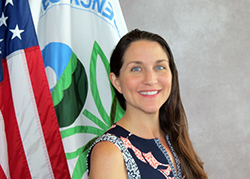Comparison Studies on Radiation Risk and Dose Assessment Models for Radioactively Contaminated Soil, Inside Buildings and Outside Surfaces
Sponsored by: U.S. EPA Office of Superfund Remediation and Technology Innovation
Archived: Monday, March 26, 2018
Comparison Studies on Radiation Risk and Dose Assessment Models for Radioactively Contaminated Soil, Inside Buildings and Outside Surfaces
2018-03-26
U.S. EPA Office of Superfund Remediation and Technology Innovation
A participant for the Oak Ridge Institute for Science and Education Research Participation Program, Nasser Shubayr, while at EPA's Office of Superfund Remediation and Technology Innovation has worked on five research projects on risk and dose assessment models recommended by governmental agencies for investigating radioactively contaminated soil, inside buildings and outside surfaces. These research projects studied 17 models and look-up that are used nationally and internationally. This webinar presents:
- overview for 9 of the models and the look-up table, NCRP 129 that address contaminated soil,
- review of selected default input parameters used by each models addressing soil,
- radiation and chemical assessment methodological consistency between US EPA and UK Environmental Agency,
- overview of 4 models used to assess contaminated outdoor surfaces, and
- comparison between EPA's 2 models and DOE model for indoor contaminated buildings.
The objective of these research projects is to make recommendations on technical and practical issues to the U.S. Environmental Protection Agency (EPA) Office of Superfund Remediation and Technology Innovation (OSRTI), facilitating better understanding of each agency's modeling approach and identifying the similarities and differences between these agencies in the risk and dose assessment of radioactively contaminated sites.
Accessibility, Recording, and Content Disclaimer
Rehabilitation Act Notice for Reasonable Accommodation
It is EPA's policy to make reasonable accommodation to persons with disabilities wishing to participate in the agency's programs and activities, pursuant to the Rehabilitation Act of 1973, 29 U.S.C. 791. Any request for accommodation should be made to Nasser Shubayr at 978-221-1793 or nshubayr@umich.edu, preferably one week or more in advance of the webinar, so that EPA will have sufficient time to process the request. EPA would welcome specific recommendations from requestors specifying the nature or type of accommodation needed. Please note that CLU-IN provides both alternate phone call-in options and closed captioning for all webinars, and requests for these specific accommodations are not necessary.
Webinar Recording
By participating in this CLU-IN webinar, you automatically agree to authorize recording of audio and visual content presented during this live event and consent to subsequent use of this recording in the public domain by the U.S. Environmental Protection Agency. This recording may include questions, comments and poll responses provided by you during the live event in addition to your name, voice, image or likeness. This recording will be made available after the conclusion of the live event as part of the CLU-IN webinar archives, and will remain available indefinitely. If you do not wish to consent to the recording, please do not join the live event, and contact Jean Balent at 202-566-0832 or balent.jean@epa.gov to discuss your concerns.
Content Disclaimer
This webinar is intended solely to provide information to the public. The views and opinions expressed as part of this webinar do not necessarily state or reflect those of the U.S. Environmental Protection Agency. It is not intended, nor can it be relied upon, to create any rights enforceable by any party in litigation with the United States, or to endorse the use of products or services provided by specific vendors. With respect to this webinar, neither the United States Government nor any of their employees, makes any warranty, express or implied, including the warranties of merchantability and fitness for a particular purpose, or assumes any legal liability or responsibility for the accuracy, completeness, or usefulness of any information, apparatus, product, or process disclosed, or represents that its use would not infringe privately owned rights.
Presenters:
Dr. Nasser Shubayr, Research Scholar in the Department of Nuclear Engineering and Radiological Sciences at the University of Michigan Ann Arbor (nshubayr@umich.edu or 978-221-1793)
Dr. Shubayr is a former Research Fellow at the EPA, the Office of Superfund Remediation and Technology Innovation. He is a consultant with the International Atomic Energy Agency, MODARIA II program, working group 1. Dr. Shubayr obtained his doctoral degree from the University of Massachusetts Lowell, Biomedical Engineering and Biotechnology — Radiological Sciences.
 Stuart Walker, U.S. EPA Office of Superfund Remediation and Technology Innovation (walker.stuart@epa.gov)
Stuart Walker, U.S. EPA Office of Superfund Remediation and Technology Innovation (walker.stuart@epa.gov)
Stuart Walker has been employed by U.S. EPA in Washington, DC since 1990 in either the Superfund program (the Office of Superfund Remediation and Technology Innovation) or the Office of Radiation and Indoor Air working on issues regarding the cleanup of contaminated sites. His primary area of responsibility includes serving as the Superfund program's national lead on issues regarding radioactively contaminated CERCLA sites. In this role, Stuart develops national policy for risk assessment including models, community involvement, compliance with Applicable or Relevant and Appropriate requirements (ARARs), establishing cleanup levels and management of radioactive contamination at CERCLA sites.
Moderator:
 Jean Balent, U.S. EPA Technology Innovation and Field Services Division (balent.jean@epa.gov or 202-566-0832)
Jean Balent, U.S. EPA Technology Innovation and Field Services Division (balent.jean@epa.gov or 202-566-0832)
Ms Balent is on the staff of the EPA's Technology Innovation and Field Services Division where she has worked to collect and disseminate hazardous waste remediation and characterization information since 2003. Ms Balent manages the Clean Up Information Network website and actively supports online communication and collaboration resources available to EPA. She formerly worked with the US Army Corps of Engineers Environmental Engineering Division in the Buffalo District. Ms Balent was also a member of the SUNY-Buffalo Groundwater Research Group where she constructed and tested large scale models of groundwater flow. Ms Balent has also conducted research relating to the Great Lakes, environmental remediation, and brownfields re-development. She holds a Bachelor's degree in environmental engineering from SUNY-Buffalo and a Master's degree in Information Technology from AIU.
Webinar Slides and References:
Webinar Slides and References:
Additional Resources:
- Overview of Radiation Risk and Dose Assessment Models for Radioactively Contaminated Sites and Selected Default Input Parameters
- Handbook of Parameters for U.S. and International Governments Risk and Dose Assessment Models for Remediation of Radiologically Contaminated Soil (PRG/DCC, RESRAD, NORMALYSA, RCLEA, RSRARS, WISMUT and NCRP)
- Study of Chemical and Radiation Risk Assessment Methods for the United States Environmental Protection Agency and the Environment Agency of the United Kingdom
- Comparison study on Radiation Risk and Dose Assessment models for Building Surfaces
- Overview of Radiation Risk Assessment Models for Radioactively Contaminated Surfaces (SPRG/SDCC, RESRAD-RDD, ERMIN)
- Preliminary Remediation Goal (PRG)
- Dose Compliance Concentration (DCC)
- RESRAD Family codes
- Bureau of Environmental Radiation, NJ. (2003). Radioactive Soil Remediation Standards (RaSoRS)
- NCRP. (1999). Recommended Screening Limits For Contaminated Surface Soil and Review of Factors Relevant To Site-Specific Studies, NCRP Report No. 129.
- U.K. DEFRA . (2003). The Radioactively Contaminated Land Exposure Assessment Methodology (RCLEA)
- NORM And LegacY Site Assessment (NORMALYSA)
- CIEMAT. [2011 (last updated in 2016)]. Screening Model for Environmental Assessment (CROM)
 Department Radiation Protection and Environment. (2011). Calculation Guide for the Determination of Radiation Exposure due to Environmental Radioactivity Resulting from Mining. Germany.
Department Radiation Protection and Environment. (2011). Calculation Guide for the Determination of Radiation Exposure due to Environmental Radioactivity Resulting from Mining. Germany.- Preliminary Remediation Goal (BPRG)
- Dose Compliance Concentration (BDCC)
- RESRAD-BUILD
- Preliminary Remediation Goal (SPRG)
- Dose Compliance Concentration (SDCC)
- RESRAD-RDD version 3.1. Environmental Assessment Division, Argonne National Laboratory, Argonne.
- Regional Screening Levels (RSL) for Chemical Contaminants at Superfund Sites electronic calculator.
- UK DEFRA. (2009). CLEA Software, version 1.05. Bristol: Environment Agency.
 Derivation Methods of Soil Screening Values in Europe. A Review and Evaluation of National Procedures Towards Harmonization
Derivation Methods of Soil Screening Values in Europe. A Review and Evaluation of National Procedures Towards Harmonization
If you have a suggested topic or idea for a future CLU-IN internet seminar, please contact:
Technology Integration and Information Branch
PH: 202-566-0832 | Email: balent.jean@epa.gov
Technology Integration and Information Branch
PH: 202-566-0875 | Email: adam.michael@epa.gov




